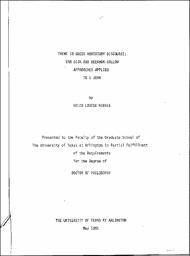
ATTENTION: The works hosted here are being migrated to a new repository that will consolidate resources, improve discoverability, and better show UTA's research impact on the global community. We will update authors as the migration progresses. Please see MavMatrix for more information.
Show simple item record
| dc.contributor.author | Miehle, Helen Louise | |
| dc.date.accessioned | 2020-10-09T20:43:55Z | |
| dc.date.available | 2020-10-09T20:43:55Z | |
| dc.date.issued | 1981-05 | |
| dc.identifier.uri | http://hdl.handle.net/10106/29501 | |
| dc.description.abstract | Two independently motivated linguistic models of text analysis (the cognitively-based model of Van Dijk and the literary-semantic approach of Beekman and Callow) are used to show that the First Epistle of John is actually hierarchical in its organization, and not merely associative as many Biblical scholars have assumed. The Van Dijk and Beekman-Callow models are also compared, contrasted and combined into a composite approach, which is then applied to the text of I John chapter one to take advantage of the pragmatic emphasis of Van Dijk and the practicality of the Beekman-Callow procedures. The two models are shown to complement each other in another way as well, namely when the thematic structures resulting from the Van Dijk and Beekman-Callow analyses are compared. The comparison serves not only to elucidate the criteria used to deciding what is thematic in the two models, but it also helps in refining the analysis of the thematic structure of the Biblical text. The aim is to provide an analysis of I John that is not only exegetically accurate and hermeneutically sound but also one that is linguistically and pragmatically based. An additional aim has been to combine three divergent aspects of text analysis: (1) constituent structure analysis, (2) analysis of the texture of a text, i.e. the interrelation of surface grammatical and deep structure meaning features, and (3) analysis of thematic structure. The ultimate goal of this study is to provide a theoretically motivated tool to assist translators, seminary students, and ministers of the Gospel in conveying the identical information content as well as in making the same impact on their hearers as John the Apostle was aiming to make on First Century Christians. For this reason, attention is paid not only to the informational structure (grammatical and semantic features) and denotative meaning, but also to the emotive and connotative meaning arising from the communication situation. On the basis of this communication situation as well as morpho-syntactic and semantic features, I John is shown to be a hortatory text with the perlocutionary function of persuasion rather than being simply an expository text written to inform. | en_US |
| dc.language.iso | en_US | en_US |
| dc.publisher | University of Texas at Arlington | en_US |
| dc.subject | Language | en_US |
| dc.subject | Literature and linguistics | en_US |
| dc.title | THEME IN GREEK HORTATORY DISCOURSE: VAN DIJK AND BEEKMAN-CALLOW APPROACHES APPLIED TO 1 JOHN | en_US |
| dc.type | Dissertation | en_US |
| thesis.degree.department | Humanities | |
| thesis.degree.name | Doctor of Philosophy in Humanities | |
Files in this item
- Name:
- Theme in Greek Hortatory Disco ...
- Size:
- 11.91Mb
- Format:
- PDF
- Description:
- PDF
This item appears in the following Collection(s)
Show simple item record


